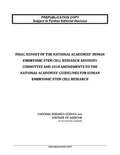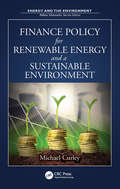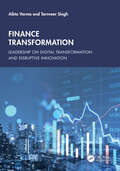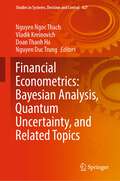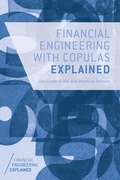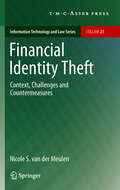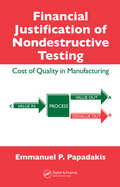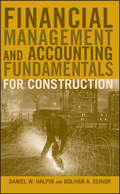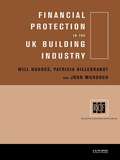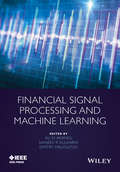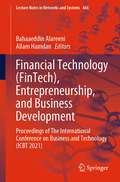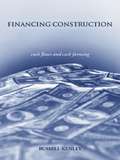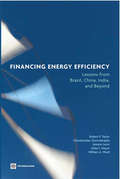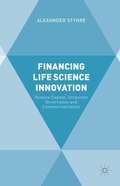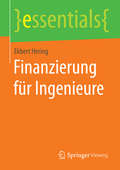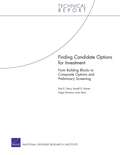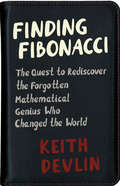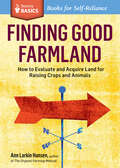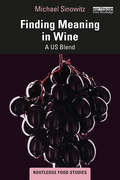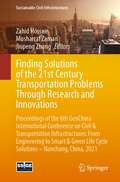- Table View
- List View
Final Report of the National Academies' Human Embryonic Stem Cell Research Advisory Committee and 2010 Amendments to the National Academies' Guidelines for Human Embryonic Stem Cell Research
by National Research Council Institute of Medicine of the National AcademiesIn 2005, the National Academies released the book, Guidelines for Human Embryonic Stem Cell Research, which offered a common set of ethical standards for a field that, due to the absence of comprehensive federal funding, was lacking national standards for research. In order to keep the Guidelines up to date, given the rapid pace of scientific and policy developments in the field of stem cell research, the Human Embryonic Stem Cell Research Advisory Committee was established in 2006 with support from The Ellison Medical Foundation, The Greenwall Foundation, and the Howard Hughes Medical Institute. As it did in 2007 and 2008, the Committee identified issues that warranted revision, and this book addresses those issues in a third and final set of amendments. Specifically, this book sets out an updated version of the National Academies' Guidelines, one that takes into account the new, expanded role of the NIH in overseeing hES cell research. It also identifies those avenues of continuing National Academies' involvement deemed most valuable by the research community and other significant stakeholders.
Finance Policy for Renewable Energy and a Sustainable Environment (ISSN)
by Michael CurleyThis book explains how environmental projects and improvements are achieved through the imposition of regulations, on the one hand, and financial incentives on the other. It discusses how those incentives can be organized to achieve the greatest environmental benefits at the lowest possible cost to the public. It presents the best environmental finance policies for the financing of alternative energy projects so that the ultimate cost of delivered power will decline. It also examines the challenges of the next generation of environmental programs.
Finance Transformation: Leadership on Digital Transformation and Disruptive Innovation
by Tarnveer Singh Aikta VarmaFinance Transformation: Leadership on Digital Transformation and Disruptive Innovation is a general and wide-ranging survey of finance transformation and emerging technologies. Finance and IT have long been important areas of any business, but recent technological developments are innovating and disrupting both. This book lays a path towards the benefits and away from potential risks. It covers the widest array of topics, from quantum computing to blockchain technology, from organisational culture and diversity to hybrid working, and from regulation to cybersecurity. Written by two vastly experienced industry professionals, this book includes real-life examples and up-to-date references. It will be of particular interest to business stakeholders, executives, and policymakers.
Finance and Control for Construction
by Chris MarchDrawing on a wealth of practical experience, both in the construction industry and teaching students, Chris March presents this study of construction management and the major aspects of controlling the building process. Covering the stages from the client's initiation, to the final handover of the building, March includes evidence from those currently working in the industry, and covers the key industry requirements: knowing that in today's market place, those entering the field must be aware of how projects are financed and controlled, and to financially run and maintain a building. Finance and Control for Construction examines the various stages, from development, through the design, to procurement and post-contract processes, and culminates in a discourse on facilities management. This book is written with a down-to-earth approach, with evidence supporting theories and principles, and is a book that students of construction management and related subjects need if they wish to succeed in the field.
Financial Econometrics: Bayesian Analysis, Quantum Uncertainty, and Related Topics (Studies in Systems, Decision and Control #427)
by Vladik Kreinovich Nguyen Ngoc Thach Nguyen Duc Trung Doan Thanh HaThis book overviews latest ideas and developments in financial econometrics, with an emphasis on how to best use prior knowledge (e.g., Bayesian way) and how to best use successful data processing techniques from other application areas (e.g., from quantum physics). The book also covers applications to economy-related phenomena ranging from traditionally analyzed phenomena such as manufacturing, food industry, and taxes, to newer-to-analyze phenomena such as cryptocurrencies, influencer marketing, COVID-19 pandemic, financial fraud detection, corruption, and shadow economy. This book will inspire practitioners to learn how to apply state-of-the-art Bayesian, quantum, and related techniques to economic and financial problems and inspire researchers to further improve the existing techniques and come up with new techniques for studying economic and financial phenomena. The book will also be of interest to students interested in latest ideas and results.
Financial Engineering With Copulas Explained
by Matthias Scherer Jan-Frederik MaiThe modeling of dependence structures (or copulas) is undoubtedly one of the key challenges for modern financial engineering. First applied to credit-risk modeling, copulas are now widely used across a range of derivatives transactions, asset pricing techniques, and risk models, and are a core part of the financial engineer's toolkit. However, by their very nature, copulas are complex and their applications are often misunderstood. Incorrectly applied, copulas can be hugely detrimental to a model or algorithm. Financial Engineering with Copulas Explained is a reader-friendly, yet rigorous introduction to the state-of-the-art regarding the theory of copulas, their simulation and estimation, and their use in financial applications. Starting with an introduction to the basic notions, such as required definitions and dependence measures, the book looks at statistical issues comprising parameter estimation and stochastic simulation. The book will show, from a financial engineering perspective, how copula theory can be applied in the context of portfolio credit-risk modeling, and how it can help to derive model-free bounds for relevant risk measures. The book will cover numerous different market applications of copulas, and enable readers to construct stable, high-dimensional models for asset pricing and risk modeling. Written to appeal to quantitatively minded practitioners across the trading floors and in risk management, academics and students, Financial Engineering with Copulas Explained will be a valuable, accessible and practical guide to this complex topic.
Financial Feasibility Studies for Property Development: Theory and Practice
by Tim HavardEssential for any real estate professional or student performing feasibility studies for property development using Microsoft Excel and two of the most commonly used proprietary software systems, Argus Developer and Estate Master DF.This is the first book to not only review the place of financial feasibility studies in the property development process, but to examine both the theory and mechanics of feasibility studies through the construction of user friendly examples using these software systems. The development process has seen considerable changes in practice in recent years as developers and advisors have adopted modern spread sheets and software models to carry out feasibility studies and appraisals. This has greatly extended their ability to model more complex developments and more sophisticated funding arrangements, saving time and improving accuracy.Tim Havard brings over 25 years of industry and software experience to guide students and practitioners through the theory of development appraisals and feasibility studies before providing internationally applicable worked examples and potential pitfalls using Excel, Argus Developer and Estates Master DF.
Financial Identity Theft
by Nicole S. van der MeulenThe existence of financial identity theft in the United States, and its (gradual) spread to other areas of the world, increases the need to understand how identity theft occurs and how perpetrators of the crime manage to take advantage of developments within contemporary society. This book aims to provide such an understanding through an in-depth comparative analysis which illustrates how states, financial service providers, consumers, and others facilitate the occurrence of financial identity theft in the United States and the Netherlands.
Financial Justification of Nondestructive Testing: Cost of Quality in Manufacturing
by Emmanuel P. PapadakisDemonstrating how to apply financial formulas to prove or disprove the utility of 100% Nondesctructive testing (NDT), this book helps readers build the financial case for their NDT projects. It not only explains how 100% inspection by high-tech methods can save money for a manufacturing organization, but also how to justify this cost. Providing examples of successful NDT implementation drawn from factory situations, the author describes high-tech inspection technology in the context of modern ISO Quality Standards, TQM theory, and Statistical Process Control. Placing NDT in the historical context of quality and inspection, the book provides three methods of calculation for proving its validity.
Financial Management and Accounting Fundamentals for Construction
by Daniel W. Halpin Bolivar A. SeniorSuccessful financial management in the construction industry begins with this hands-on guideWhile construction professionals are skilled in the technical side of their work, they often find the financial management aspect of the business daunting. Financial Management and Accounting Fundamentals for Construction will help you better understand and navigate the financial decisions that are part of every construction project.This book is a compact summary of the basic financial skills that a construction professional must have to be successful in the management of a construction company and its projects. Its topics address many of the questions that any construction administrator will face, such as:How to organize and use a company's financial reportsWhat amount of cash must be made available to the contractor to complete a projectWhy the early payment of supplier invoices can enhance profitabilityHow to quantify the time value of money in financial decisionsWhat tax amount is owed by a company and how it impacts the bottom lineHow to control project costsWhat financial sources are available to a construction contractor for capital expansionIn this text, you will learn about accounting fundamentals, project-related financial matters, and company level financial issues--three factors that are key to your career success. An ideal reference for students of construction management and engineering, as well as professionals who need a quick refresher when dealing with cost control analysis and other financial issues, this text also offers:Easy-to-understand coverage of financial concepts specific to the construction industry, including business taxation, project control, engineering economy, and financial forecastingNumerous worked examples, plus end-of-chapter review questions and exercisesHelpful appendices that present the structure of a typical chart of accounts, the flow of transactions through a construction accounting system, and tables required for computing interest and the time value of money
Financial Management in Construction Contracting
by Andrew Ross Peter WilliamsThis authoritative text provides a detailed insight into how construction companies manage their finances at both corporate and project level. It will guide students and practitioners through the complexities of the financial reporting of construction projects within the constraints of accepted accounting practice. The book is written for non-accountants and from a contractor’s perspective and is equally relevant to subcontractors and main contractors. The authors examine the relationship between the external annual accounts and the internal cost-value reconciliation process. CVR is covered in depth and the authors consider issues such as interim payments, subcontract accounts, contractual claims, final accounts, cash flow management and the reporting of the physical and financial progress of contracts. A broad perspective of all the financial aspects of contracting is taken along with related legal issues and the authors explain how things operate in the ‘real world’. They describe good practice in financial control while at the same time being honest about some of the more questionable practices that can - and do - happen. The approach taken is unique as the financial management of construction projects is considered from the perspective of the contractor’s quantity surveyor. The book deals with the real issues that surveyors have to address when using their judgment to report turnover, profitability, cash flow, and work in progress on projects and the financial problems faced by subcontractors are frankly and pragmatically explored. The payment and notice requirements of the Construction Act are explained in detail and relevant provisions of JCT2011, NEC3, ICC, DOM/1 and other standard contracts and subcontracts are also covered. Financial Management in Construction Contracting addresses the wide variety of external factors that influence how construction companies operate, including government policy, banking covenants and the financial aspects of supply chain management. Cost reporting systems are described and real-life examples are used to illustrate cost reports, accrual systems and how computerised systems can be employed to provide the QS with information that can be audited. Examples drawn from practice demonstrate how work-in-progress (WIP) is reported in contracting. Cost value reconciliation reports are featured and the book demonstrates how adjustments are made for overmeasure, undermeasure, subcontract liabilities and WIP as well as explaining the processes that contractors use when analysing external valuations. This is the ideal core text for final year degree and post-graduate level modules on Quantity Surveying, Commercial Management, Construction Management and Project Management courses and will provide an invaluable source of reference for quantity surveyors and others who may be engaged in the financial management of construction projects. The book’s companion website at www.wiley.com/go/rossfinancialmanagement offers invaluable resources for students and lecturers as well as for practising construction managers: end-of-chapter exercises + outline answers PowerPoint slides for each chapter ideas for discussion topics links to useful websites
Financial Modelling and Asset Valuation with Excel
by Morten Helbæk Ragnar Løvaas Jon Olav MjølhusFinance is Excel! This book takes you straight into the fascinating world of Excel, the powerful tool for number crunching. In a clear cut language it amalgamates financial theory with Excel providing you with the skills you need to build financial models for private or professional use. A comprehensive knowledge of modeling in Excel is becoming increasingly important in a competitive labour market. The chapters in part one start with the most basic Excel topics such as cell addresses, workbooks, basic formulas, etc. These chapters get more advanced through part one, and takes you in the end to topics such as array formulas, data tables, pivot tables, etc. The other parts of the book discusses a variety of subjects such as net present value, internal rate of return, risk, portfolio theory, CAPM, VaR, project valuation, asset valuation, firm valuation, loan, leasing, stocks, bonds, options, simulation, sensitivity analysis, etc.
Financial Protection in the UK Building Industry: Bonds, Retentions and Guarantees
by Will Hughes John Murdoch Patricia HillebrandtFinancial Protection in the UK Building Industry provides comprehensive treatment of an increasingly important but complex aspect of construction management. The term 'Financial Protection' refers to the various mechanisms by which funds are made available to ensure the due performance of a party's contractual obligations.This book looks at the legal and economic background to the problem of providing financial protection to clients to guard against poor performance and/or the insolvency of contractors, consultants and sub-contractors. The inclusion of practical guidance notes and summaries makes this a valuable guide for the construction professional as well as for the researcher.
Financial Signal Processing and Machine Learning (Wiley - IEEE)
by Ali N. Akansu Sanjeev R. Kulkarni Dmitry MalioutovThe modern financial industry has been required to deal with large and diverse portfolios in a variety of asset classes often with limited market data available. Financial Signal Processing and Machine Learning unifies a number of recent advances made in signal processing and machine learning for the design and management of investment portfolios and financial engineering. This book bridges the gap between these disciplines, offering the latest information on key topics including characterizing statistical dependence and correlation in high dimensions, constructing effective and robust risk measures, and their use in portfolio optimization and rebalancing. The book focuses on signal processing approaches to model return, momentum, and mean reversion, addressing theoretical and implementation aspects. It highlights the connections between portfolio theory, sparse learning and compressed sensing, sparse eigen-portfolios, robust optimization, non-Gaussian data-driven risk measures, graphical models, causal analysis through temporal-causal modeling, and large-scale copula-based approaches. Key features: Highlights signal processing and machine learning as key approaches to quantitative finance. Offers advanced mathematical tools for high-dimensional portfolio construction, monitoring, and post-trade analysis problems. Presents portfolio theory, sparse learning and compressed sensing, sparsity methods for investment portfolios. including eigen-portfolios, model return, momentum, mean reversion and non-Gaussian data-driven risk measures with real-world applications of these techniques. Includes contributions from leading researchers and practitioners in both the signal and information processing communities, and the quantitative finance community.
Financial Technology: Proceedings of The International Conference on Business and Technology (ICBT 2021) (Lecture Notes in Networks and Systems #486)
by Allam Hamdan Bahaaeddin AlareeniThis book constitutes the refereed proceedings of the International Conference on Business and Technology (ICBT2021) organized by EuroMid Academy of Business & Technology (EMABT), held in Istanbul, between 06–07 November 2021. In response to the call for papers for ICBT2021, 485 papers were submitted for presentation and inclusion in the proceedings of the conference. After a careful blind refereeing process, 292 papers were selected for inclusion in the conference proceedings from forty countries. Each of these chapters was evaluated through an editorial board, and each chapter was passed through a double-blind peer-review process.The book highlights a range of topics in the fields of technology, entrepreneurship, business administration, accounting, and economics that can contribute to business development in countries, such as learning machines, artificial intelligence, big data, deep learning, game-based learning, management information system, accounting information system, knowledge management, entrepreneurship, and social enterprise, corporate social responsibility and sustainability, business policy and strategic management, international management and organizations, organizational behavior and HRM, operations management and logistics research, controversial issues in management and organizations, turnaround, corporate entrepreneurship, innovation, legal issues, business ethics, and firm governance, managerial accounting and firm financial affairs, non-traditional research, and creative methodologies.These proceedings are reflecting quality research contributing theoretical and practical implications, for those who are wise to apply the technology within any business sector. It is our hope that the contribution of this book proceedings will be of the academic level which even decision-makers in the various economic and executive-level will get to appreciate.
Financing Construction: Cash Flows and Cash Farming
by Russell KenleyCash is king, not least in the construction industry. Recent government-commissioned reports have highlighted the importance of better financial management in the construction industry. This professional text provides a considered analysis of the tools and techniques of project financial management in construction; notably it covers cash flow modelling and provides the first detailed investigation of the contentious issue of cash farming. Through use of case studies, worked examples and questions this book will appeal to practitioners and students alike.
Financing Energy Efficiency: Lessons from Brazil, China, India, and Beyond
by Jeremy Levin Chandrasekar Govindarajalu Anke S. Meyer Robert P. Taylor William A. WardWhile energy efficiency projects could partly meet new energy demand more cheaply than new supplies, weak economic institutions in developing and transitional economies impede developing and financing energy efficiency retrofits. This book analyzes these difficulties, suggests a 3-part model for projectizing and financing energy efficiency retrofits, and presents thirteen case studies to illustrate the issues and principles involved.
Financing Life Science Innovation
by Alexander StyhreThe life sciences are widely treated as a field and an industry with high-growth potential, and while neoclassical economic theory prescribes that capital are invested in emerging industries, there is a perceived shortage of venture capital among life science entrepreneurs. Financing Life Science Innovation reviews the literature on venture capital, corporate governance, and life science venturing and presents a study of the Swedish life science industry and the venture capital investors being active in financially and managerially supporting life science start-up firms. The study reveals that venture capital investors, life science entrepreneurs, and innovation system actors today face the challenge of supplying adequate amounts of capital to an industry that may produce tomorrow's health care innovations. Changes in scientific research practices, the structure of the international finance market, and industry policy are all contributing to what is frequently treated as a shortage of venture capital in the life sciences.
Finanzierung für Ingenieure (essentials)
by Ekbert HeringDie meisten Ingenieure in der Praxis werden vor Finanzierungsaufgaben gestellt und müssen hierfür die optimalen Finanzierungsmöglichkeiten bereitstellen. Deshalb werden in diesem Band die Finanzierungsarten und die Finanzierungsinstrumente vorgestellt. Es wird gezeigt, welche wichtigen Informationen eine Finanzanalyse bieten kann und wie eine Finanzplanung für ein Unternehmen erstellt wird.
Find Your Way Around JCT 98 (Find Your Way Round... S. Ser.)
by Richard WoolleyStandard contracts published for use in the construction industry are complex documents and contain many inter-related clauses. This book will enable the user to find easily not just the main references dealing with a particular topic, but also the related clauses and references. In facing any contractual problem, it is the practitioner's primary duty to discover all the relevant references and make a judgement, which is not possible until all references have been covered. This book identifies the main topics which a practitioner will encounter, giving all the references to each topic which may be scattered throughout the document and a one-line signpost to indicate the contents of each reference.
Finding Candidate Options for Investment
by Justin Beck Paul K. Davis Russell D. Shaver Gaga GvineriaDescription of a methodology and a prototype tool, Building Blocks To Composite Options Tool (BCOT), for identifying investment options for defense capability areas. It ensures that a broad range of options is considered initially, then uses a screening technique to narrow the range to those meriting more-extensive assessment in a fuller portfolio-analysis framework. BCOT extends classic economics and operations-research techniques and suggests pragmatic approximations, particularly in capabilities-based planning.
Finding Fibonacci: The Quest to Rediscover the Forgotten Mathematical Genius Who Changed the World
by Keith DevlinIn 2000, Keith Devlin set out to research the life and legacy of the medieval mathematician Leonardo of Pisa, popularly known as Fibonacci, whose book Liber abbaci has quite literally affected the lives of everyone alive today. Although he is most famous for the Fibonacci numbers—which, it so happens, he didn't invent—Fibonacci's greatest contribution was as an expositor of mathematical ideas at a level ordinary people could understand. In 1202, Liber abbaci—the "Book of Calculation"—introduced modern arithmetic to the Western world. Yet Fibonacci was long forgotten after his death, and it was not until the 1960s that his true achievements were finally recognized.Finding Fibonacci is Devlin's compelling firsthand account of his ten-year quest to tell Fibonacci's story. Devlin, a math expositor himself, kept a diary of the undertaking, which he draws on here to describe the project's highs and lows, its false starts and disappointments, the tragedies and unexpected turns, some hilarious episodes, and the occasional lucky breaks. You will also meet the unique individuals Devlin encountered along the way, people who, each for their own reasons, became fascinated by Fibonacci, from the Yale professor who traced modern finance back to Fibonacci to the Italian historian who made the crucial archival discovery that brought together all the threads of Fibonacci's astonishing story.Fibonacci helped to revive the West as the cradle of science, technology, and commerce, yet he vanished from the pages of history. This is Devlin's search to find him.
Finding Good Farmland: How to Evaluate and Acquire Land for Raising Crops and Animals. A Storey BASICS® Title (Storey Basics)
by Ann Larkin HansenBuying farmland is a major investment, so be sure you make an informed choice. This practical guide covers every factor you should consider before making a purchase, including government regulations, residential concerns from the surrounding area, soil conditions, and savvy financing. Whether you intend to grow abundant crops or graze a robust herd of livestock, Finding Good Farmland provides a roadmap to the land that’s right for you.
Finding Meaning in Wine: A US Blend (Routledge Food Studies)
by Michael SinowitzThis book examines controversies in American wine culture and how those controversies intersect with and illuminate current academic and cultural debates about the environment and about interpretation. With a specific focus on the United States of America, the methods that we use to discuss literature and other art are applied to wine-making and wine culture. The book explores the debates about how to evaluate wine and the problems inherent in numerical scoring as well as evaluative tasting notes, whether winemakers can be artists, the discourse in wine culture involving natural wine and biodynamic farming, as well as how people judge what makes a wine great. These interpretative commitments illuminate an underlying metaphysics and allegiance to a culture of reason or feeling. The discussions engage with a broad range of writers and thinkers, such as Roland Barthes, Susan Sontag, Louis Menand, Michael Pollan, Greg Garrard, John Guillory, Amitov Ghosh, Pierre Bourdieu, and Barbara Herrnstein-Smith. The book draws upon not only a number of texts produced by wine critics, wine writers, literary critics and theorists but also extensive interviews with wine writers and multiple California winemakers. These interviews contribute to a unique reflection on wine and meaning. This book will be of great interest to readers looking to learn more about wine from cultural, literary, and philosophical perspectives.
Finding Solutions of the 21st Century Transportation Problems Through Research and Innovations: Proceedings of the 6th GeoChina International Conference on Civil & Transportation Infrastructures: From Engineering to Smart & Green Life Cycle Solutions -- Nanchang, China, 2021 (Sustainable Civil Infrastructures)
by Musharraf Zaman Zahid Hossain Jiupeng ZhangThis volume presents challenges in transportation infrastructures and geotechniques, advancements in recycling, soil stabilization and reinforcement technologies, and assessments of roadway conditions using modern tools and techniques. The articles presented in this volume focus on fundamental investigations on various aspects of civil engineering materials and structures. The scope of this volume is the application of findings for solving problems in geotechnical, pavement, concrete and transportation engineering using through smart, green and emerging techniques. The primary audience of this work will be researchers, professionals, and practitioners around the world. This volume is based on contributions to the 6th GeoChina International Conference on Civil & Transportation Infrastructures: From Engineering to Smart & Green Life Cycle Solutions -- Nanchang, China, 2021.
